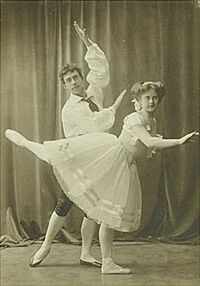Napoli (ballet) facts for kids
Quick facts for kids Napoli, or The Fisherman and His Bride |
|
|---|---|

Richard Jensen and Grethe Ditlevsen in the pas de six in 3rd act of Napoli, 1909
|
|
| Choreographed by | August Bournonville |
| Composed by | Holger Simon Paulli Edvard Helsted Niels W. Gade H.C. Lumbye |
| Libretto by | August Bournonville |
| Date of premiere | 29 March 1842 |
| Place of premiere | Royal Danish Theatre, Copenhagen, Denmark |
| Original ballet company | Royal Danish Ballet |
| Characters | Gennaro Veronica Teresina A monk Giacomo Peppo Giovanina Pascarillo Carlino Golfo Coralla Argentina |
| Setting | Naples and the Blue Grotto, Italy |
| Genre | Romantic ballet |
Napoli, or The Fisherman and His Bride is a famous ballet created in 1842. It was made for Denmark's Royal Ballet by a Danish choreographer named August Bournonville. The ballet tells an exciting story about Teresina, a young Italian girl. She falls in love with Gennaro, a fisherman. The story ends with the happy marriage of the two lovers.
Contents
Story of Napoli
This ballet has three acts, each telling a part of Teresina and Gennaro's adventure.
Act I: The Market
Teresina's mother, Veronica, did not want her to marry poor Gennaro. She introduced Teresina to two rich, older men, Peppo and Giacomo. But Teresina said no to both of them. She went to wait for Gennaro instead.
When Gennaro came back to port, he and Teresina went to find Veronica. They tried to convince her that they should get married. Luckily for them, Veronica saw how much the young couple loved each other. She agreed to their marriage. Full of happiness, Teresina and Gennaro sailed off together.
Meanwhile, some entertainers put on a show for the townspeople. But a big storm suddenly began. The fun stopped quickly. When the storm ended, Gennaro was found, but Teresina was gone. Veronica thought Teresina had drowned. She was very sad and blamed Gennaro for her daughter's disappearance.
Gennaro was very upset by this. He calmed down when he saw a statue of the Madonna. Soon, Fra Ambrosio, the local monk, appeared. He gave Gennaro a picture of the Madonna. He told Gennaro to go and find Teresina.
Act II: The Blue Grotto
Gennaro looked everywhere for Teresina. He finally found her in the Blue Grotto. This was a magical place ruled by Golfo, a sea demon. Golfo had turned Teresina into a naiad, a fairy of the sea.
Because of this change, Teresina could not remember Gennaro. But with faith and the Madonna's picture, Teresina changed back into a human. Her memory also came back. Quickly, Gennaro and Teresina left the Grotto to return to Naples.
Act III: The Wedding
When Teresina and Gennaro returned, the townspeople were suspicious. They had thought Teresina was dead. Peppo and Giacomo even tried to tell everyone that Gennaro was working with the devil.
This rumor was soon proven false. Then, the wedding party began. Everyone celebrated the happy couple.
Main Characters
Here are the main characters you will meet in Napoli:
- Teresina: A young Italian girl who is deeply in love with Gennaro.
- Gennaro: A young Italian fisherman who loves Teresina.
- Veronica: Teresina's mother.
- Peppo: A rich, older lemonade seller who wants to marry Teresina.
- Giacomo: An older, but rich, macaroni seller who also wants to marry Teresina.
- Fra' Ambrosio: A kind monk who helps Gennaro.
- Golfo: The sea demon who rules the Blue Grotto.
Music of the Ballet
Many composers helped create the music for Napoli. Edvard Helsted and Holger Simon Paulli wrote the music for Acts I and III. Niels W. Gade created the special music for the Blue Grotto in Act II. This included a popular song called La Melancholie.
Bournonville asked Hans Christian Lumbye to write the music for the final dance, a galop. Lumbye later became famous for his music at the Tivoli Gardens.
Bournonville wrote in his memories that he hummed the first parts of the tarantella in Act III during a long carriage ride. This tarantella dance then became the main idea for the whole ballet.
In Act I, music from Rossini's opera The Barber of Seville is used for Peppo's scene. The folk song Te voglio ben assai is used in Act I to show the young lovers' feelings. The Latin hymn "O Santissima" is used in Act II. It shows how Christianity helps against Golfo's magic.
See also
- List of ballets by title
- Flower Festival in Genzano

